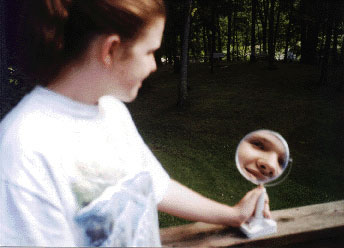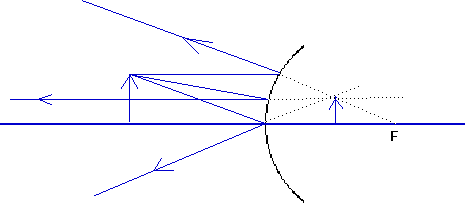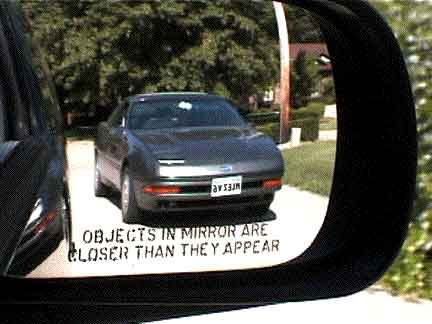

Images Formed by Curved Mirrors
We will focus our attention on three principal rays that are easy to follow and will also representative of the other rays involved in image formation.

We already know that an image is formed -- or something is "seen" -- when light rays diverge from a point. Here, light rays that originate at point O on the object strike a curved mirror and are reflected there so they converge to point I and then diverge from point I as they continue on their way. If our eyes detect these rays, we will see an image at point I. This is how an image is formed.

While this image is formed by all the rays that leave the object and strike the mirror, we will concentrate on three principal rays because they are easy to follow.

In fact, we will usually ignore all the other rays and locate an image by drawing only the principal rays.


The object distance do, the image distance di, and the mirror's focal length f are related by the image equation,

Further examples:
Consider an object placed between the focal point and the mirror, for a concave mirror:
 The image formed is virtual (the light does not really pass through the image location). The image formed is right-side-up. And the image is larger than the object. This is the way a make-up mirror or a shaving mirror works.
The image formed is virtual (the light does not really pass through the image location). The image formed is right-side-up. And the image is larger than the object. This is the way a make-up mirror or a shaving mirror works.
Consider an image produced by a convex mirror:

The passenger side rear view mirror on your car is a convex mirror.

Be sure to note and remember the differences between real images and virtual images.
di > 0 for a real image. di < 0 for a virtual image.

Consider an object placed 50 cm in front of a concave mirror with a focal length of f = + 30 cm. Where is the image located? Describe the image.
By "curved mirrors", we mean "spherical mirrors". However, it is also fun to look at the iamges formed by cylindrical mirrors.
%26.gif)
(c) Doug Davis, 2003; all rights reserved


Return to Ch 24, Mirrors and Lenses